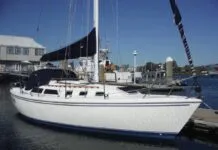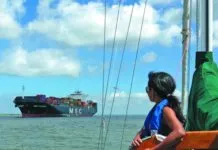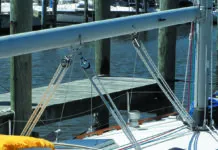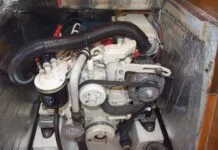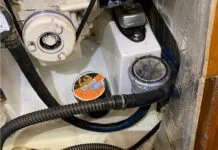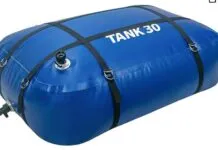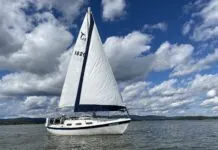Roller furling makes headsail handling a whole lot easier, but it also results in a significant loss in light-air efficiency. This stems from the fact that the light No. 1 genoa and the hank-on drifter/reacher have become orphans without a stay on which to hank. The process of peeling a boltrope-fed genoa out of a furler slot and replacing it with another, even larger sail is an arduous task at best, one that makes a traditional hank-on headsail swap seem like easy business.

The real problem, however, begins when the breeze kicks up and the excess sail area of the lightweight sail must be diminished, not by roller reefing, but by dropping the sail and replacing it again with the heavyweight genoa. This swap involves sails that lack hanks, and do not remain tethered to a headstay while being doused. Light-air, loose-luff sails love to go over the side. Because of these issues, many sailors reluctantly accept the poor, low-end performance of a fairly flat cut, heavy furling genoa, and make up for its shortfalls with diesel fuel.
A new generation of light-air roller-furling sails aims to resolve these issues. They require no fixed stay, and on a properly equipped boat, can be set, furled, doused, and dropped with relative ease. Interestingly, these new gennaker or code zero furlers share some similarities with early, forgettable jib furler designs.
Before roller-furling headsail gear evolved into the safe, reliable equipment of today, there was quite a bit of experimentation with foil-less, swiveling head-and-tack systems that allowed sails with sewn-in wire luffs to function as both a furling mechanism and a permanent headstay. This “all the eggs in one basket” scenario had a downside that was much more serious than the prospect of a torn headsail. Early malfunctions resulted in the industry shift to slotted foils that were placed over a permanent headstay-a decision that ushered in a safe, reliable roller-furling revolution.
However, a new twist on the old technology drew attention during a re-start sequence of Race 2 in the 2000 Americas Cup, when the Kiwis dragged a bag onto the foredeck of their AC boat and set a sail that set a new standard in light-air performance.
The crafty New Zealanders had baited the stylish Italians aboard Prada into following them on a long hitch away from the starting line. The breeze was light, and as soon as the Kiwis tacked, they hoisted a lightweight, furled-on-itself headsail coined a “code zero.”
It unrolled with a whoosh and left the Italians in the proverbial dust. As the two boats headed toward the start line, it was indeed a rabbit and turtle race. Contrary to folklore, the Kiwis proved to be a smart rabbit, and the gains they made with the code zero and their consummate sailing skills still stand today.
What We Tested
Our testing focused on the assumption that if light-air sails could be made easier to handle and offer better performance, more cruisers and day sailors would opt to expand their sail inventory. Asymmetric spinnakers, gennakers, and good old lightweight drifter/reachers have been around for a while, but the latest trend is to take a few lessons from the Kiwis and grand prix racers around the world and stick them on a sprit. And by toning down the dimensions a bit, the result was a tame version of the sport-boat sail plan that can up the average sailors light-air fun.
We tested seven models. Five of the units we tested were head-swivel and tack-drum designs with the sail luff acting as the torsion-inducing member. In conventional roller-furling designs, a slotted, rotating foil sleeves the headstay, connecting the tack drum and the head swivel, and causing the head and tack of the headsail to rotate almost simultaneously, even though the torque is introduced only at the tack point.
Many sprit-furlers are linked by only the sail luff, and are designed to operate without metal torsion tubes. They cause the sail to start furling from the tack upward, because it takes a few wraps to cause the luff to transfer the torque. Of those we tested, only Cruising Designs Inc.s (CDI) Spinnaker Furler and Bamars Roll-Gen incorporate a torque rope connection between the swivel and the drum, along with a unique swivel process that causes all of the torsion generated by pulling the endless line to be transmitted to the head of the sail. Therefore, the furling becomes a top-down rather than a bottom-up process.
All test units except the Schaefer 650 used an endless loop of Dacron to rotate the furling drum. The taper used in creating the end-to-end splice was crucial, because any increase in line diameter became very apparent as the line traveled through the friction groove in the drive drum. Line lead was also of paramount importance, and by either splicing bullet blocks into the endless loop, or using small snatch blocks, it was easy to keep the run of the endless loop fair, and make line handling more efficient.
Bamar
Bamars Roll-Gen is similar in operation to the CDI furler. It incorporates a caged drum, eliminating any issues with a furling line jumping, and a mechanical end-of-line clamp that allows an owner to cut the torque line to fit the exact length of the sail it will be used with.
Another interesting feature of the system is its ability to be used as either a torsion-rope furler intended for loose-luff assyms, or to be used without the torque rope as a drum-and-swivel furling system for code sails and drifter/reachers. The key to this dual capability is the simple quick release of the torsion rope, inversion of the head swivel and removal of the anti-rotation rod. This allows the head of the sail to spin freely, while the tack drum induces the twist moment to the luff of the sail.
This hardware flip-flop changes where the torque is directed, and extends the furling process along the length of the luff, rather than a top-down affair.
Bottom Line: Fittings are well thought-out, and the overall construction of the unit is excellent. Testers also liked the duality of the unit and rated it as a Recommended product.
Colligo
The Colligo Cn-5 is a large, nicely machined and finished piece of gear thats boldly anodized and exceptionally smooth in operation. The large diameter of the drum wheel increases torque, magnifying the rotational effect from a given amount of line pull. Testers found the head swivel equally smooth running, but it is also big. When setting and dousing, testers concern for their noggins rose in proportion with head swivel size. The unit we tested was large enough to function quite well aboard a boat much larger than our 41-foot test boat. It proved to be the most powerful product tested thanks to both its large drum diameter and smooth bearing system.
Bottom Line: A rugged, attractive, and efficient unit. Its large top swivel and minor details hold it out of the top spot.
Cruising Design Inc.
Cruising Designs Inc.s Spinnaker Furler will work with loose-luff nylon sails as well as lightweight Dacron reachers. The drum is rotated at the base, but the tack of the sail actually spins on a Delrin bushing, allowing the torque to be transferred to the head of the sail, via the stiff rope. This winds the sail in a top-down context. A nylon sail, with little or no extra leading-edge reinforcement, to be effectively furled. The downside: Its a little trickier to keep the nylon from puckering and pinching itself, causing overrides. CDIs new spinnaker furler ($850) replaces the aluminum spool with a larger-diameter plastic spool that better prevents the line from slipping off.
Bottom Line: If you go this route with a nylon, loose-luff sail, work closely with your sailmaker to get the right shape.
Facnor
One of the early leaders in free-flying furlers, Facnor makes the FX 2500 is an elegantly engineered system. It is small in size but proved that it really has what it takes to handle a code sail, drifter, or gennaker. The 750-square-foot radial clew drifter that we used fit right into the jaws of the drum and swivel, and the units simple but functional capture ring kept the endless loop from jumping out of the groove. Facnor uses uniquely engineered spring tensioners to hold clevis pins in place. Testers found that these are easy to use and make the unit easy to handle. The stainless-steel cage surrounding the furling sheave allows easy installation of a furling line.

Facnor also offers the Asym-FX, a torsion-rope version designed for asymmetric spinnaker furling.
Bottom Line: Rated our Best Choice, this well-executed piece of gear nosed slightly ahead of the other high-quality units in this test.
Harken
Harkens Code Zero MKII furler system has a proven track record aboard modern race boats and is more than up to the task on a cruising boat. In addition to our test boat and bench testing, we checked out the Harkens functional applicability aboard a new Alan Andrews-designed custom 39-footer that sports the modern small-jib, big-main sail plan, and a built-in carbon bowsprit. The code zero furler was used to tame a massive, lightweight No. 1 genoa that nearly doubled the headsail area.
The Harken Code Zero furler incorporates easy-to-use tack and head pins that are held captive by an innovative piston-locking function. It offers an easy-loading feature to engage the endless furling line.
Bottom Line: The user-friendly Harken is pricey, but it also has the highest safe working load of the group. Harkens smaller 3101 (5000- pound SWL) is about $900 less.
Karver
Even smaller than the Facnor, the Karver Kf2 packs big sail-handling ability into a very compact package. Like the Facnor, it uses clevis-pin tethers, but its retaining clips are a little harder to use, in our opinion. The quick line-feeding system is even quicker in the newer version released after our test.

Its bearing setup was not quite as friction-free as others tested, but it proved to work efficiently on both the larger and smaller test platforms. In fact, it made gennaker handling on our Cape Dory 19 a snap. And by furling the sail before dousing it during a deep reach, it made single-handing in 20 knots of wind a smooth sailing experience.
Bottom Line: A good small-boat furler that is priced right.
Schaefer
This unit has a “Back to the Future” flair. Its a new, lightweight rendition of the Schaefer technology used to pioneer the companys early roller furling. The unit is not an endless loop, but instead is a miniaturized alloy drum and spool, set up for a fairly small-diameter furling line. The light, free-spinning top swivel is made of aluminum hardware and multiple races of high-molecular-weight Torlon plastic bearings. Its only downside is that when it comes to furling a large headsail, lots of line is needed on the relatively small drum, mandating a fairly thin line thats a little less friendly to handle.

Bottom Line: Not the most elegant or compact, but it worked well in testing, and the price is very attractive. A no brainer for our Budget Buy.
Conclusion
Sailing in 5- to 10-knot conditions with a 135-percent heavy genoa can prove to be anything but an exhilarating experience. More often than not, it results in a premature desire to turn the ignition key.
Not only are too many sailors missing the pure fun of light-air sailing, one of the most enjoyable aspects of the sport, but with fuel prices skyrocketing, enhancing your boats light-air ability under sail makes more sense than ever before.
There were no lemons among the furlers we tested. However, the Facnor Fx 2500 did stand out enough to get our cream-of-the-crop nod for PS Best Choice. For loose luff asymmetric spinnaker users, Bamars Roll-Gen nudged out the CDI unit. At about half the price of some other furlers in our test, the Schaefer furler is the choice for PS Budget Buy.
When it comes to using a sock or a furler for asymmetric control, the furler has a slight edge over the sock, provided the sail is a good match, in our opinion.
Testers also found that proper halyard tension was important, and the polyester-covered, Spectra-cored spinnaker halyard we used limited stretch and proved to be very easy to handle. Finding a happy balance in halyard tension made furling easier-too little, and the luff bowed to leeward, making furling difficult; too much tension put excess load on the bearings and also decreased the ease of furling. Light sheets were also a big plus. Ring-type pin fasteners can snag sheet covers causing damage to lines and even the unintentional removal of a keeper pin.
When all is said and done, adding light-air sailing ability to a daysailer or cruising boat is well worth the extra effort and expense.





